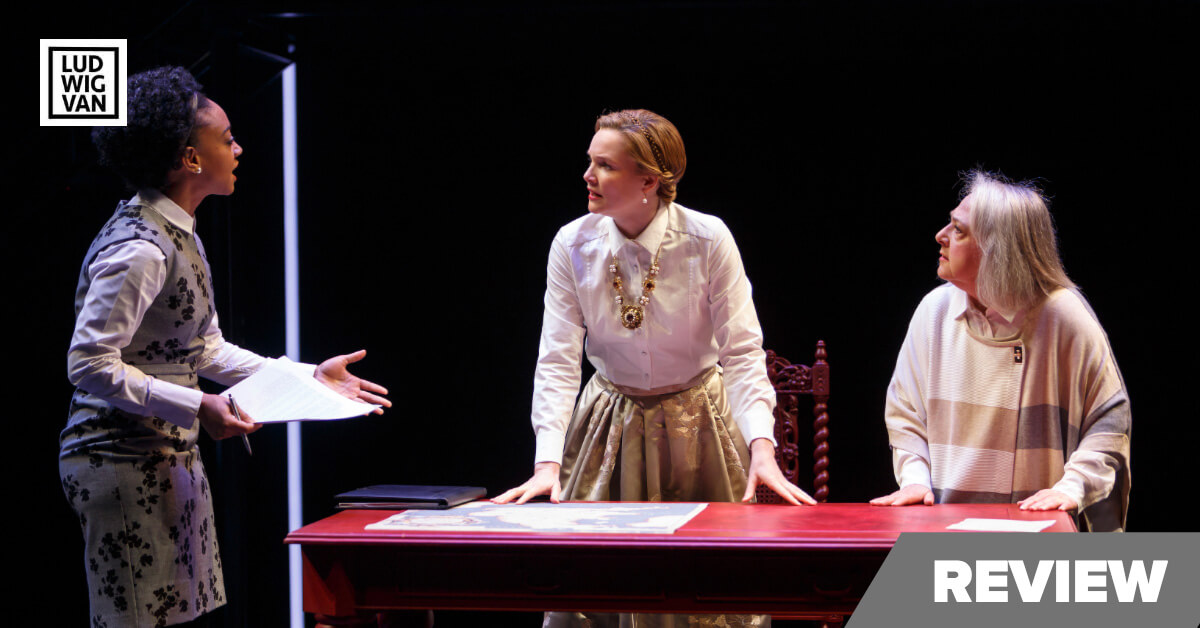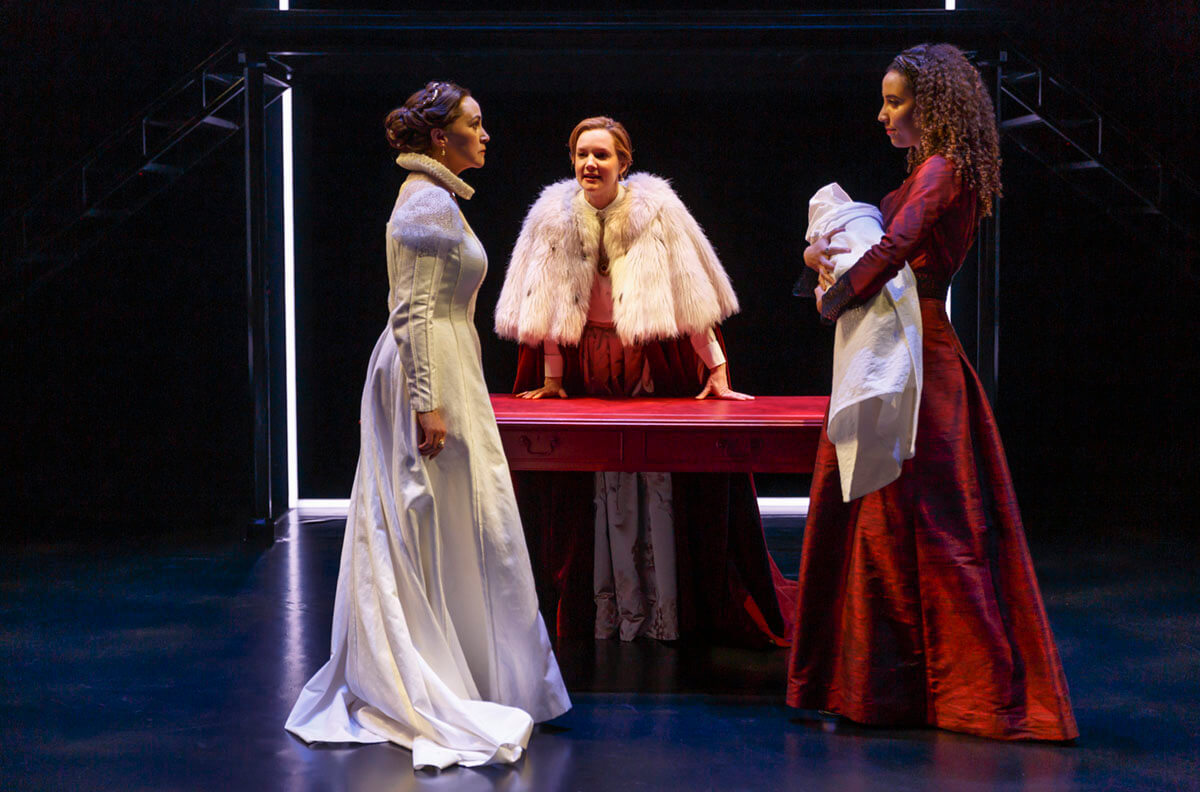
Stratford Festival 2019/Mother’s Daughter by Kate Hennig, directed by Alan Dilworth, Studio Theatre, June 14 to Oct. 13. Tickets available at stratfordfestival.ca.
Kate Hennig’s Queenmaker trilogy is one of the Stratford Festival’s most successful ventures, generating an enduring catalogue of plays that are getting produced on international stages. The world premiere of the last, Mother’s Daughter, is perhaps the best yet, albeit a first among equals.
Hennig’s wellspring for the trilogy is the concept of women and power, with the lives of Tudor queens being her concentration. The protagonist of the first play, The Last Wife (2015), is Henry VIII’s number six, Katherine Parr. The Virgin Trial (2017) features a young Elizabeth I, while the last play, Mother’s Daughter showcases Elizabeth’s older half-sister Mary I.
The most seductive element in Hennig’s plays is her mix of colloquial language and subversive ideas. Her queens spout the four-letter vulgar of today while grappling with power at the highest level. It is how these women manipulate and even abuse power that makes for the dark underbelly of the plays. The subversiveness is rendered in Hennig’s wry sense of history as she throws in ideas out of left field, along with character twists and turns that catch us by surprise. Hennig’s queens are more than representatives of known facts from the history books. They are complicated, contemporary women fighting the forces of a patriarchal society. Some of the queens are stronger than others, but all are survivors, and that is what matters.
In Mother’s Daughter, Mary (Shannon Taylor) is tormented by the ghost of her mother, Catalina, a.k.a Katherine of Aragon, Henry VIII’s number one (Irene Poole). Catalina’s ghostly avatar’s mission is to push Mary to secure her succession and restore Catholicism. Enriching the plot is Mary’s complicated relationship with her sister Bess (Jessica B. Hill), a force of Protestantism. Actor Hill also doubles as Bess’s mother, Anne Boleyn, Henry VIII’s number two.
There is also a touching subplot focusing on Mary’s troubled relationship with her cousin and rival for the throne, Lady Jane Grey (Alexandra Lainfiesta). Rounding out the cast are Beryl Bain as the courtier Bassett, Maria Vacratsis as Mary’s companion Susan, and Gordon Patrick White as Simon, the lone token male. (Hennig always has at least one male actor in the cast.) The latter three are the Greek chorus of politicos who push and pull Mary in her quest for power.
The great tragedy, as it plays out in Hennig’s design, is that Mary started out with the best of intentions — moderation, compassion and compromise — but circumstances turned her into a ruthless warrior. Remember, she was called Bloody Mary, but Hennig rewrites history with her sympathetic portrayal. Her Mary is witty, smart, sarcastic, passionate, cutting and cruel by turn, while being endlessly fascinating. If I have one little quibble, there is a fair bit of plot repetition as various people keep putting forth the same advice to Mary with each encounter.

The stage is awash in strong performances. Taylor is incandescent as Mary, at once feminine and fragile, but a steel magnolia at heart. It is a brilliant performance that finely details Mary’s complex journey to power. Also strong is Hill who telegraphs in her portrayal of the feisty young Bess, the cunning, sly, wily Elizabeth to be. Poole and Vacratsis are two of my favourite actors. Poole, with her rich, velvety yet powerful voice and commanding aura, is a choking juggernaut, crushing Mary to her will. Her Catalina is one scary lady, obsessed with redressing the injustices done to her by Henry. Vacratsis is always able to play with irony, and while her Susan is a Mary loyalist, we also hear the exasperation in her voice as well as veiled humour. Lainfiesta is the understudy for Jane, but although her voice was a bit low, she did a very good job at projecting Jane’s naïve nature encased in inner strength. Bain and White form a suitably officious and forceful presence on stage. Mary needs their strength.
Kudos to director Dilworth who shepherded all three plays to the stage, and lets the characters shine through. The simplicity of his staging, coupled with the excellence of his pacing, creates a game of thrones, as it were, that is crackling with tension. The action and dialogue are relentless. Lorenzo Savoini’s ornate, gothic table and chair encapsulate power, and nothing else is needed on stage. Kimberly Purcell’s bars of neon lights outline the edge of the stage and doors, and hiss with static, putting a fittingly garish quality on the struggles within. Debashis Sinha has created an electronic sound design that captures the menace afoot in Mary’s court.
And finally, a big shout out to Savoini’s brilliant character-specific costumes. Mary starts off in a conservative, but attractive, long skirt and blouse, and progresses into black military attire. Bess begins in an ultra-chic military uniform, whose jacket comes off to reveal a cute pinafore effect, reminding us how young she is. Catalina is in severe white sixteenth-century dress, covered head to toe, while Anne Boleyn sports a sexy and very revealing lounging gown. Pious Jane is dressed like a Quaker, Susan wears a maiden aunt’s pantsuit, while Bassett is a drab apparatchik. The lone man simply does not stand out in his suit — sorry about that.
Now, if we could only see the three plays in one go to allow us to gather Hennig’s musings on power all together. What a treat that would be.
LUDWIG VAN TORONTO
Want more updates on classical music and opera news and reviews? Follow us on Facebook, Instagram or Twitter for all the latest.
- INTERVIEW | Actor Diego Matamoros Takes On Icon Walt Disney In Soulpepper Production Of Hnath Play - April 16, 2024
- SCRUTINY | Opera In Concert Shine A Light On Verdi’s Seldom Heard La Battaglia Di Legnano - April 9, 2024
- SCRUTINY | Lepage & Côté’s Hamlet Dazzles With Dance And Stagecraft Without Saying Anything New - April 5, 2024



